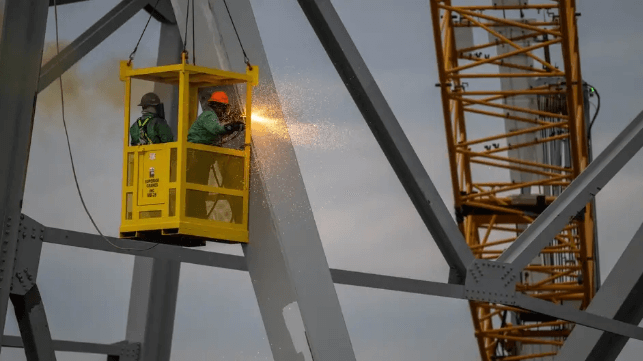Demolition Contractors Remove First Piece of Baltimore Bridge's Wreckage

On Saturday, contractors for the U.S. Army Corps of Engineers began removing the first piece of the wrecked Francis Scott Key Bridge, launching a carefully-planned process to clear a channel and reopen the Port of Baltimore. The work will proceed around the clock, Maryland Gov. Wes Moore said at a press conference Saturday.
The demolition teams are beginning work to the north of the main span, and their first task will be to open up an auxiliary shallow-draft channel.
"We'll continue planning efforts for once we open that up for tug and barge traffic to come into the Port of Baltimore," said Coast Guard 5th District Commander Rear Adm. Shannon Gilreath at a press conference Saturday. "Even if it's not the deep draft [channel], we want to take advantage of that opportunity."
After the debris is cleared, the auxiliary channel will be carefully surveyed to determine draft restrictions. The Coast Guard will place buoys to outline the safe fairway for tug operators. Traffic may be subject to restrictions in order to ensure that it does not interfere with the work to clear the rest of the bridge, Gilreath said.
As predicted by many shipping analysts, other East Coast ports are absorbing Baltimore's containerized cargo without much difficulty, Virginia Port Authority's Steve Edwards told CBS. "I think the economic shock is local," he said. "It's not across the region, and it's not across the nation." Port of Baltimore is on many of the same service strings as the much larger Port of New York and New Jersey and the Port of Virginia, so Baltimore-bound boxes can be offloaded at earlier or later port calls and then trucked to their final destinations. With the late-pandemic import boom long over, other East Coast ports have spare capacity to accept extra cargo.
The alternative arrangements for offloading ro/ro cargo - cars and rolling equipment - are less clear; Baltimore leads the nation in these cargo categories, and only one of its ro/ro terminals is still functioning. "This is the No. 1 auto port in the entire United States, so there will absolutely be some disruption when you have both import and export vehicles. But we don't know the extent of disruption because companies are working on ways to reroute things," said Alliance for Automotive Innovation CEO John Bozzella.
In the meantime, Port of Baltimore's land-side operations remain open, and longshore workers continue to send import cargo out the gates for final-mile delivery. The port is also exploring other opportunities to bring longshoremen back to work until shipping resumes.

that matters most
Get the latest maritime news delivered to your inbox daily.
As the bridge is dismantled, the wreckage will be transported to a scrapping site at nearby Tradepoint Atlantic, Dredging Contractors of America CEO Bill Doyle told The Maritime Executive. He could not give an exact timeline for the work's completion, but said that it would be faster than many observers might think, thanks to an abundance of available private-sector resources.
Workers at the bridge site have two barge cranes on scene to assist, one rated at 650 tons and one at 330 tons. The East Coast's heaviest crane barge, the Chesapeake 1,000, is standing by to assist when needed. In addition to the resources of the Army Corps of Engineers and its contractors, the U.S. Navy's Supervisor of Diving and Salvage has chartered additional barges to carry wreckage and is mobilizing 12 support vessels to Baltimore, according to Navy Times.
